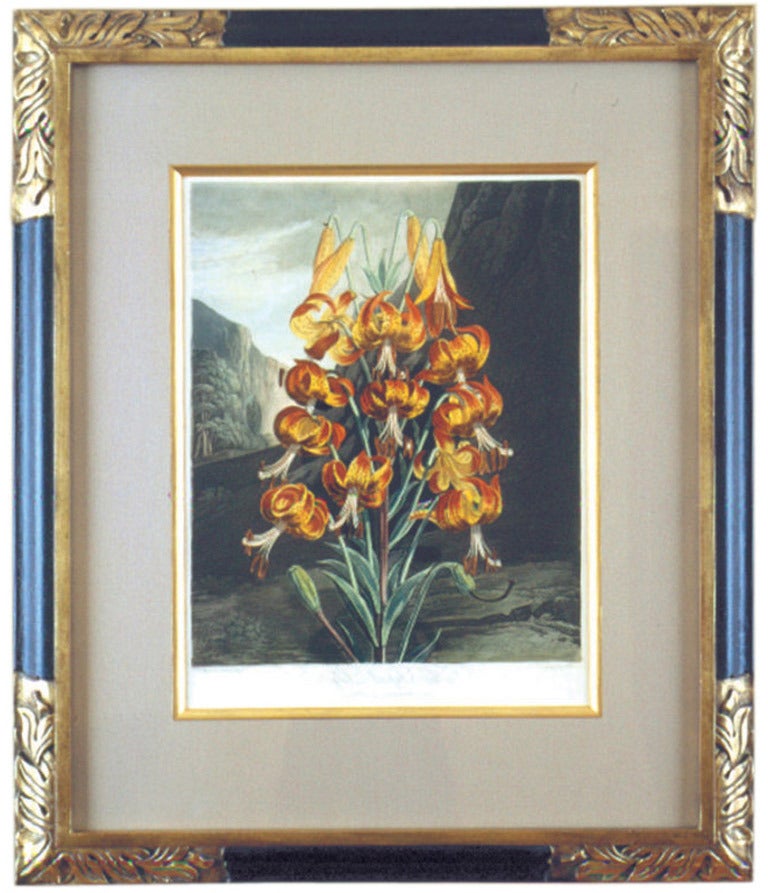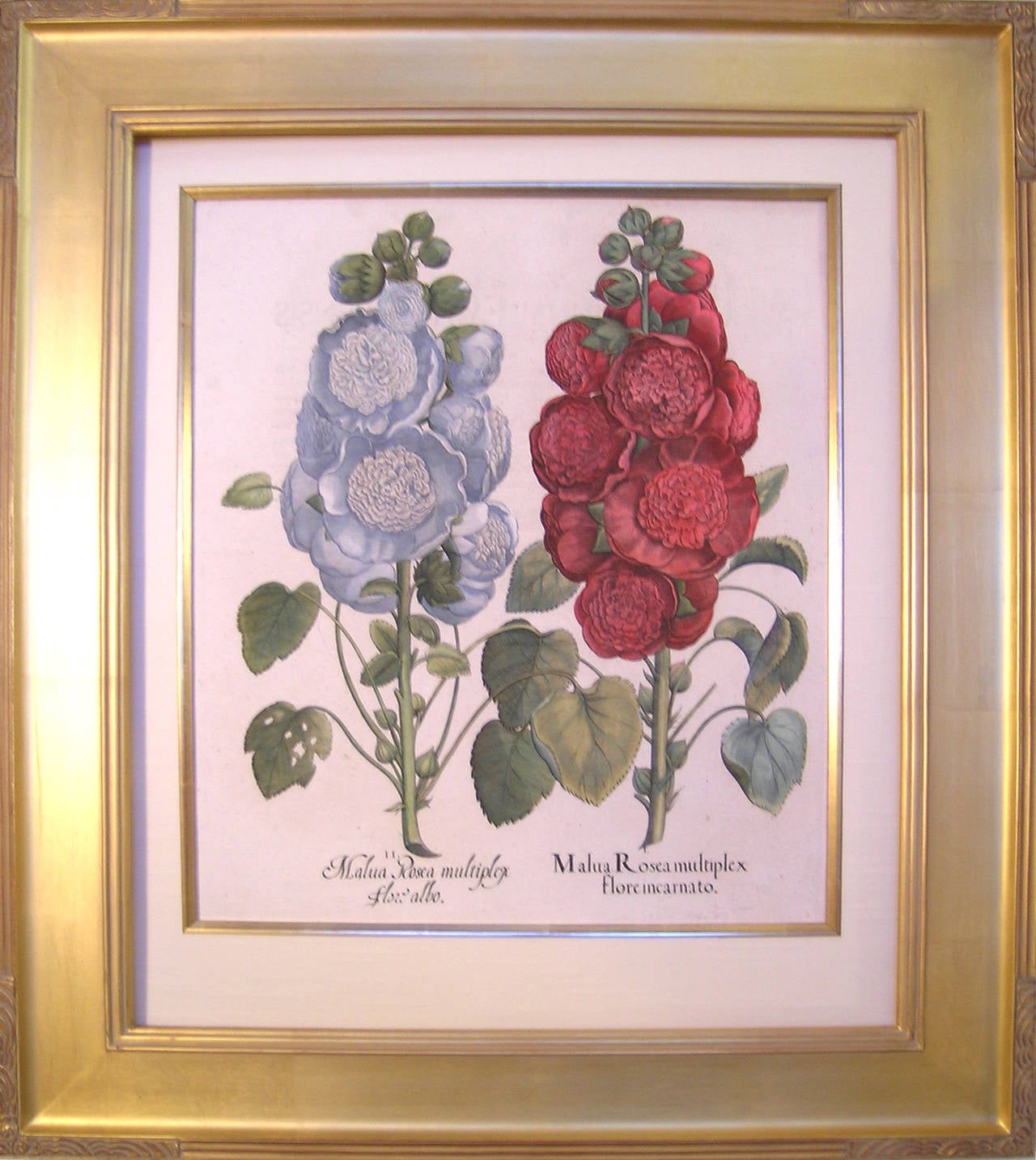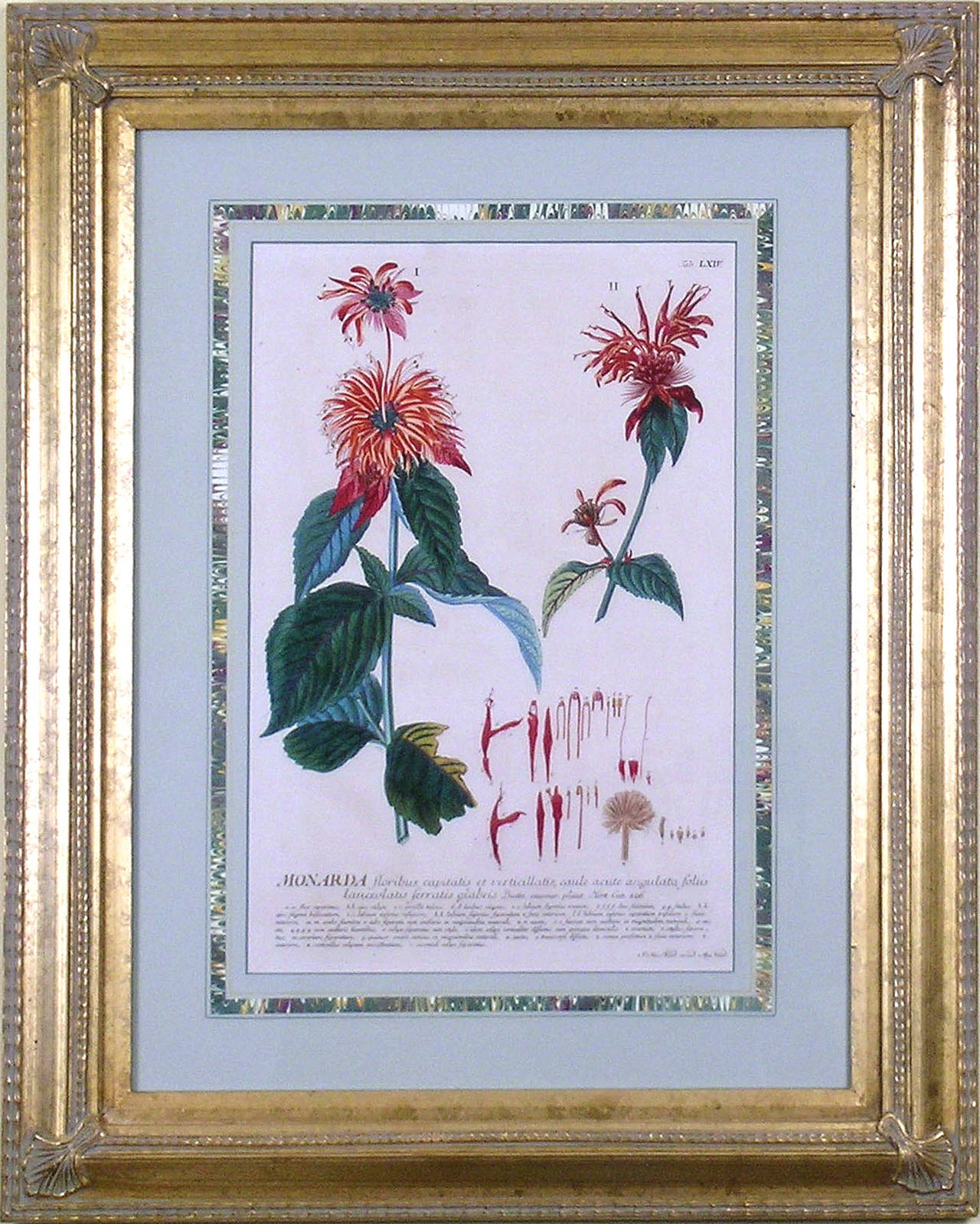Items Similar to Agave or American Aloe
Want more images or videos?
Request additional images or videos from the seller
1 of 7
Dr. Robert John ThorntonAgave or American Aloe1812
1812
About the Item
DR. ROBERT JOHN THORNTON (c1765 – 1832).
The Temple of Flora… (Lottery Edition).
London, 1812.
Painted by Reinagle, Henderson, Pether, et. al.
Engraved by Gaugain, Dunkarton, Maddox, et. al.
Aquatint, mezzotint, and/or stipple engraving finished by hand.
Approximately 12.25” x 16” unframed.
27 Plates.
As a boy, Robert John Thornton (d.1837) demonstrated his love of natural history with his own botanical garden and an aviary, which contained every species of English hawk, most of them captured by himself. He took his Cambridge M.B. and, following in his father's footsteps, set up practice as a London doctor. Upon inheriting the family fortune in 1797, Thornton desired to leave his mark on the world in the form of a massive work dedicated to Carolus Von Linnaeus, the great Swedish naturalist. For his own aggrandizement and that of his beloved England, Thornton wished it to surpass in scope, illustration, paper, and topography any publication produced in any other European country. He felt he was engaged upon "a national undertaking", and dedicated this homage of philosophic and literary distinction to Queen Charlotte. It was to be titled The Temple of Flora; or Garden of Nature Picturesque Botanical Plates of the New Illustration of the Sexual System of Linnaeus. Desiring the national glorification of botany and its alliance with the arts of painting and engraving, Thornton was the first person to juxtapose landscape backgrounds with his floral subjects. He opened an art gallery of the paintings from which the prints were made and subscriptions for the forthcoming books were sold. Copies of the work were sent to the Queen and Prince Regent, and to the Emperor of Russia, who sent Thornton a ring in acknowledgment of the "splendid and elaborate Botanical works."
The Thornton prints, originally to number seventy in all, were barely published in an edition of thirty at the author's expense between the years 1799 and 1807. Despite his efforts, Thornton was unable to succeed financially. Technically The Temple of Flora, as it came to be known, was not a success due to botanical inaccuracies and rather insipid text all based on Thornton's aesthetic sense. However, it is the forceful stylization of flowers, together with their historical, allegorical and fanciful backgrounds that place The Temple of Flora among the greatest botanical books of all time.
Though Thornton actually painted only one picture used for the engravings in his Temple, "The Roses", he literally directed his flower pictures. He chose the plants, arranged the symbolism and the backgrounds. For example, in the "Night-Blowing Cereus" the moon illuminates the turret clock, which has just struck midnight, the hour when this flower is fully open. Henderson, Reingal, Edwards and Pether are among the artists hired by Thornton to work on the flower designs and their backgrounds. Many times they would collaborate, as in the aforementioned "Cereus" where it states "The Flower by Reinagel, Moonlight by Pether". These plates were executed by the likes of Bartolozzi and other English master engravers and are a varied combination of mezzotint, aquatint, stipple engraving and finished in watercolor by hand. The text, primarily composed by Thornton, was lengthy, somewhat fanciful and included rather exaggerated poetry. Thornton was a man of his era, a time of romanticism, when artistic tastes ran to the sentimental, symbolic, and dramatic. The flowers from the Temple of Flora are delightful examples of that style.
In spite of tremendous public exposure and a dedication to Queen Charlotte, Thornton's venture was a financial disaster. While he attributed this to the continental war, no doubt his over-zealous attention to details, none too scientific, largely contributed to his failure. By 1811, Thornton was forced to petition Parliament for permission to set up a lottery. "An Act to enable Dr. Robert John Thornton to dispose of his collection of paintings, drawings and engravings, together with several copies of certain books therein mentioned, by way of chance" was passed in May of that year. Thus, the Quarto or Lottery edition of The Temple of Flora was published. This work, smaller in scale but not in romantic spirit, was to salvage Thornton's expenses for the original folio edition. Hoping to sell twenty thousand tickets at two guineas each, Thornton estimated the worth of his ten thousand prizes to be 77,000 pounds. This was a generous estimate as the complete sale of tickets would be worth no more than 42,000 pounds. Once again, Thornton's venture resulted in disaster. For the remaining years of his life, Thornton continued his medical practice with varying success, and attempted a brief, unhappy collaboration with the poet William Blake. Sadly when he died in 1837 his family was almost destitute. But despite these early failures, The Temple of Flora has now a permanent place as one of the greatest prizes of all time.
Reference:
Flower & Fruit Prints. Dunthorne. Da Capo Press. Washington, D. C., 1938.
The Temple of Flora: Robert Thornton. King. Little, Brown and Company, NY, 1981.
- Creator:Dr. Robert John Thornton (1768 - 1837, English)
- Creation Year:1812
- Dimensions:Height: 25 in (63.5 cm)Width: 21.25 in (53.98 cm)Depth: 1.25 in (3.18 cm)
- Medium:
- Movement & Style:
- Period:
- Condition:Clean, crisp image. Full margins. Beautiful original color.
- Gallery Location:Florham Park, NJ
- Reference Number:
Dr. Robert John Thornton
Robert John Thornton (1765-1832) was attracted to natural history at an early edge and created his own botanical garden and an aviary as a boy. He graduated from Cambridge with a medical degree and set up practice as a London. He inherited his family fortune in 1797, which allowed Thornton the opportunity to devote time to his lifelong goal of creating an extensive scholarly work dedicated to the great classical Swedish naturalist, Carolus Von Linnaeus (1707-1778), also known as Carl von Linné, who developed a system for the classification of plants and animals, and is known as the father of taxonomy. Thornton's goal was to exceed any previous publication produced in any European country in terms of the scope of the project, the quality of the illustrations and the paper, as well as the beauty of the landscapes depicted as backgrounds for the plants. Thornton was the first person to incorporate landscape backgrounds with his botanical subjects. He wanted for the publication to be of both academic importance as well as artistic beauty. He dedicated his work and subsequent publication "The Temple of Flora; or Garden of Nature Picturesque Botanical Plates of the New Illustration of the Sexual System of Linnaeus" to Queen Charlotte. Thornton opened an art gallery to display the paintings from which the prints were made and as a place to sell subscriptions to the forthcoming books. Queen Charlotte, the Prince Regent, and the Emperor of Russia received copies of the book. Although the publication was not successful financially for Thornton, the stylization of the illustrated flowers and their historical, allegorical and fanciful backgrounds led to The Temple of Flora being considered one of the greatest botanical books of all time.
About the Seller
5.0
Vetted Seller
These experienced sellers undergo a comprehensive evaluation by our team of in-house experts.
1stDibs seller since 2014
161 sales on 1stDibs
Typical response time: 2 hours
- ShippingRetrieving quote...Ships From: Florham Park, NJ
- Return PolicyA return for this item may be initiated within 1 day of delivery.
More From This SellerView All
- The Superb LilyBy Dr. Robert John ThorntonLocated in Florham Park, NJDR. ROBERT JOHN THORNTON (c1765 – 1832). The Temple of Flora. London, 1798-1810. Painted by Reinagle, Henderson, Pether, et. al. Engraved by Ward, Caldwall, Earlom, et. al. A...Category
18th Century and Earlier Academic Prints and Multiples
MaterialsArchival Paper, Watercolor, Archival Tape, Engraving, Gesso, Handmade Pa...
- Peaches XXXIVBy George BrookshawLocated in Florham Park, NJGEORGE BROOKSHAW (1751 – 1823). Pomona Britannica of a Collection of the Most Esteemed Fruits…. Engravers R. Brookshaw and H. Merke. London, 1812. Aquatint and stipple engravings...Category
Early 19th Century Academic Prints and Multiples
MaterialsArchival Paper, Watercolor, Archival Tape, Gesso, Handmade Paper, Plexig...
- Malva Rosea (Hollyhock, Mallow)By Basilius BeslerLocated in Florham Park, NJThis piece would pair well with Basil Besler's "Malva hortensis flore..." which is also listed BASIL BESLER (1561 – 1629). Hortus Eystettensis. Konrad ...Category
18th Century and Earlier Academic Prints and Multiples
MaterialsArchival Paper, Watercolor, Archival Tape, Gesso, Handmade Paper, Laid P...
- Malva hortensis flore... (Hollyhock, Mallow)By Basilius BeslerLocated in Florham Park, NJThis piece would pair well with Basil Besler's "Malva Rose" which is also listed. BASIL BESLER (1561 – 1629). Hortus Eystettensis. Konrad Bauer. Altdo...Category
18th Century and Earlier Academic Prints and Multiples
MaterialsSilk, Archival Paper, Archival Tape, Gesso, Handmade Paper, Laid Paper, ...
- Purple Grapes.By Maria Sibylla MerianLocated in Florham Park, NJThis piece would pair well with Maria Sibylla Merian's "Green Grapes; which is also listed. MARIA SIBYLLA MERIAN (1647-1717) Metamorphosis Insectorum Surinamensium… (Insects of Su...Category
18th Century and Earlier Academic Prints and Multiples
MaterialsSilk, Archival Paper, Archival Tape, Gesso, Handmade Paper, Laid Paper, ...
- Monarda (aka Bee Balm, Bergamot)By Georg Dionysius EhretLocated in Florham Park, NJGEORGE DIONSYSIUS EHRET (1708-1770). Plantae Selectae.... Text by Dr. Christoph Trew. Drawn by Georg Dionsysius Ehret. Engraved by Johannes Jacobus and Johannes Elias Haid. Nure...Category
18th Century and Earlier Academic Prints and Multiples
MaterialsGold Leaf
You May Also Like
- Color-Blast BouquetBy Dionisios FragiasLocated in New York, NYDionisios Fragias is a New York -based artist born on the Greek island of Kefalonia and raised in New York City. He is the protege of the artist Jeff Koons whose years-long mentorshi...Category
2010s Abstract Abstract Prints
MaterialsArchival Tape, Archival Ink, Archival Paper, Color, Archival Pigment
- “Bank Notes”By James GillrayLocated in Southampton, NYJames Gillray (13 August 1756 – 1 June 1815) was a British caricaturist and printmaker famous for his etched political and social satires, mainly published between 1792 and 1810. Many of his works are held at the National Portrait Gallery in London. Description: Pitt (left) as a bank-clerk, very thin and much caricatured, a pen thrust through his wig, stands behind an L-shaped counter offering a handful of bank-notes to John Bull. In his right hand is a scoop with which he sweeps up notes from the counter. John is a yokel no longer bewildered. He stands stolidly, holding out his left hand for the notes, his right hand in his coat pocket. Fox (right) wears a high cocked hat...Category
1790s Academic Figurative Prints
MaterialsEtching, Archival Paper
- “La Femme aux Figues”By Paul GauguinLocated in Southampton, NYOriginal etching and lavis in black ink on Arches watermarked crème laid paper by Paul Gauguin. Titled: “La Femme aux Figues” (The Woman with Figs). This impression is from the 3rd s...Category
1970s Academic Figurative Prints
MaterialsArchival Paper, Etching
- Chartres La Mort de la Viegre X111”Located in Southampton, NYOriginal photo mechanical print handcolored throughout by the French artist, Lucy Garnot. Signed and titled bottom. Circa 1900. Condition is very go...Category
Early 1900s Academic Figurative Prints
MaterialsArchival Paper, Photogravure
- “Placidas and the Stag”Located in Southampton, NYOriginal photo mechanical print handcolored throughout by the French artist, Lucy Garnot. Signed left bottom. Circa 1900. Condition is very good. T...Category
Early 1900s Academic Figurative Prints
MaterialsArchival Paper, Photogravure
- “Scene in Union Square, New York on a March DayBy Winslow HomerLocated in Southampton, NYOriginal wood engraving on paper. Taken from Harper’s Weekly, April 7, 1860. Signed “Homer” in the plate. Condition is good. Slight staining lower left. Very slight tear to the l...Category
1860s Academic Figurative Prints
MaterialsArchival Paper, Engraving
Recently Viewed
View AllMore Ways To Browse
Antique Or
Dr Brown
Gray Floral Prints
19th Century Plates America
Dr John
Antique And Salvage
Antique Tape
Floral Print Set
London Antique Handmade
Antique Floral Prints
Antique Floral Print
Set Of Floral Prints
Style And Salvage
Floral Drawing Print
Botanical Print Sets
Botanical Print Set
Set Of Botanical Prints
Sets Of Botanical Prints






